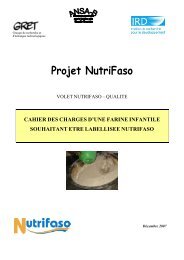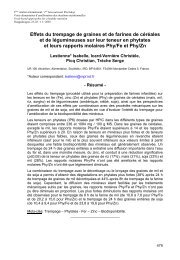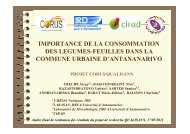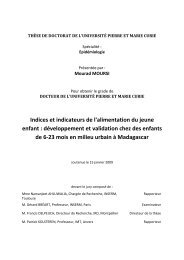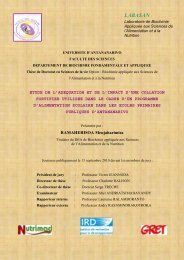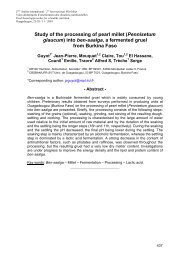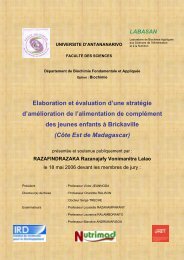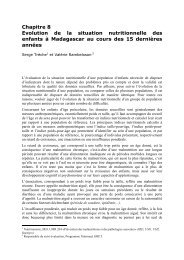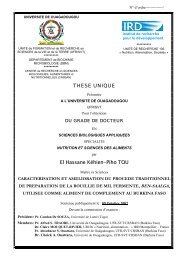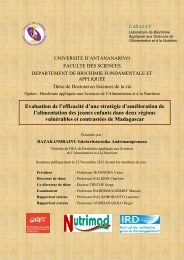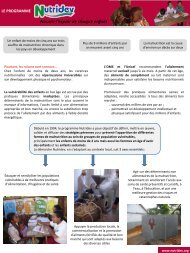Required nutritional, organoleptic and sanitary ... - Nutridev
Required nutritional, organoleptic and sanitary ... - Nutridev
Required nutritional, organoleptic and sanitary ... - Nutridev
You also want an ePaper? Increase the reach of your titles
YUMPU automatically turns print PDFs into web optimized ePapers that Google loves.
<strong>Required</strong> <strong>nutritional</strong>, <strong>organoleptic</strong> <strong>and</strong> <strong>sanitary</strong><br />
characteristics of fermented <strong>and</strong> unfermented<br />
gruels used as complementary foods in<br />
developing countries<br />
Trèche S, Mouquet C, Guyot JP<br />
Institut de Recherche pour le Développement (IRD)<br />
UR 106 “Nutrition, Alimentation, Sociétés”<br />
WHO collaborating Centre for Nutrition<br />
“Food safety under extreme conditions”, Int. Conference, Jaén 6-8/09/ 2004
Introduction<br />
‣ Protein-energy malnutrition (PEM), in particular stunting, still affects<br />
about one third of pre-school children in developing countries<br />
‣ Stunting is associated with:<br />
- delays in mental <strong>and</strong> motor development<br />
- increased risk of morbidity <strong>and</strong> mortality<br />
‣ In most situations growth failure <strong>and</strong> malnutrition appear just after the<br />
introduction of complementary foods (CF) <strong>and</strong> prevalences of stunting<br />
reach a maximum when children are about 15 to 20 months old<br />
‣ Taking into account the simultaneity of the apparition of PEM <strong>and</strong> of the<br />
introduction of CF <strong>and</strong> as:<br />
Total energy <strong>and</strong><br />
nutrient intakes<br />
Energy <strong>and</strong> nutrient<br />
intakes from breastmilk<br />
Energy <strong>and</strong> nutrient<br />
intakes from CF<br />
= +<br />
⇒ There are probably strong relations between PEM <strong>and</strong> CF
Introduction<br />
These relations can be:<br />
Direct: - insufficient energy or micronutrient absorption due to<br />
inadequate CF intakes or <strong>nutritional</strong> value<br />
or<br />
Indirect:<br />
- reduction of breast milk intakes when CF are introduced too early<br />
- CF may cause foodborne diseases (diarrhoea or parasitic infections)<br />
- CF may reduce the nutrient bioavailability of the whole diet<br />
Thus, from six months of age, children must have access to CF which:<br />
‣ are free of pathogens <strong>and</strong> contaminants<br />
‣ have high energy <strong>and</strong> nutrient density, well balanced <strong>nutritional</strong><br />
composition <strong>and</strong> low anti<strong>nutritional</strong> factor contents<br />
‣ have appropriate <strong>organoleptic</strong> characteristics, particularly suitable<br />
consistency <strong>and</strong> taste<br />
‣ <strong>and</strong> are economically accessible, culturally acceptable <strong>and</strong><br />
easy-to-prepare.
Definition of complementary foods (CF)<br />
Any liquid or solid nutrient-containing<br />
foods given to infants <strong>and</strong> young<br />
children in addition to breastmilk<br />
The first CF given to infants generally:<br />
‣ consist in special transitional foods (as gruel, porridge, pap…)<br />
prepared from blends of flours or fermented cereal doughs<br />
‣ are characterised by a semi-liquid consistency<br />
The present contribution serves a triple purpose:<br />
Introduction<br />
‣ To summarize the required <strong>nutritional</strong>, <strong>organoleptic</strong>, <strong>sanitary</strong><br />
<strong>and</strong> socio economical characteristics of CF<br />
‣ To o briefly review the main (bio)technological(<br />
processes which<br />
can be used to confer these required characteristics to CF<br />
‣ To o suggest some practical <strong>and</strong> inexpensive ways of<br />
control
<strong>Required</strong> characteristics<br />
The <strong>nutritional</strong> characteristics have to correspond with<br />
the physiological <strong>and</strong> anatomical constraints concerning<br />
infant feeding:<br />
High energy <strong>and</strong> nutrient requirements<br />
Limited gastric capacity (~30-40 ml/kg of body weight)<br />
Reduced ability to swallow solid food<br />
⇒ Necessity to design CF with<br />
- high energy <strong>and</strong> nutrient density<br />
- semi-liquid consistency<br />
- sufficiently bioavailable essential (micro)nutrients
<strong>Required</strong> <strong>nutritional</strong> characteristics<br />
On account of the frequent changes in <strong>nutritional</strong><br />
recomm<strong>and</strong>ations, it is important to keep in mind the<br />
principle for calculating required energy <strong>and</strong> nutrient<br />
density of CF:<br />
Energy or nutrient<br />
needed from CF<br />
Desired average<br />
energy or nutrient<br />
density in CF<br />
=<br />
Energy or nutrient<br />
-<br />
requirements<br />
=<br />
Energy or nutrient<br />
/<br />
needed from CF<br />
Energy or nutrient<br />
consumed from<br />
breastmilk<br />
Total amount of<br />
CF consumed
<strong>Required</strong> <strong>nutritional</strong> characteristics<br />
Estimation of the minimum energy density for CF (kcal/100g)<br />
Class<br />
of age<br />
Requirement<br />
(kcal/day)<br />
Average<br />
+2SD<br />
Energy<br />
intake from<br />
breastmilk<br />
(kcal/day)<br />
Energy that a<br />
child must be<br />
able to<br />
consume from<br />
CF (kcal/d)<br />
Gastric<br />
capacity<br />
(ml)<br />
Minimum energy<br />
density depending<br />
on the number of<br />
meals per day<br />
2m/d<br />
3m/d<br />
4m/d<br />
6-8<br />
months<br />
615<br />
769<br />
Low<br />
Av.<br />
217<br />
413<br />
552<br />
356<br />
249<br />
111<br />
71<br />
74<br />
48<br />
55<br />
36<br />
9-11<br />
months<br />
686<br />
858<br />
Low<br />
Av.<br />
157<br />
379<br />
701<br />
479<br />
285<br />
123<br />
84<br />
82<br />
56<br />
61<br />
42<br />
12-23<br />
months<br />
894<br />
1118<br />
Low<br />
Av.<br />
90<br />
346<br />
1028<br />
772<br />
345<br />
149<br />
112<br />
99<br />
75<br />
74<br />
56<br />
Source: adapted from WHO/NUT/98.1; Dewey <strong>and</strong> Brown, 2003
Minimum nutrient contents<br />
Digestible protein<br />
Lipids<br />
Calcium<br />
Iron<br />
Zinc<br />
Iodine<br />
Vitamin A<br />
Thiamin<br />
Riboflavin<br />
Folic acid<br />
2.75<br />
2.33<br />
60<br />
6.25<br />
2.27<br />
51<br />
114<br />
80<br />
80<br />
19<br />
<strong>Required</strong> <strong>nutritional</strong> characteristics<br />
contents (per 100 kcal) for 6-to-23-mo-old children<br />
g / 100 kcal<br />
g / 100 kcal<br />
mg / 100 kcal<br />
mg / 100 kcal<br />
mg / 100 kcal<br />
µg / 100 kcal<br />
µg RE / 100 kcal<br />
µg / 100 kcal<br />
µg / 100 kcal<br />
µg / 100 kcal<br />
Source: adapted<br />
from Lutter <strong>and</strong><br />
Dewey, 2003<br />
‣ But essential micronutrients must not only to be present but also<br />
bioavailable
<strong>Required</strong> <strong>organoleptic</strong> characteristics<br />
The most important <strong>organoleptic</strong> characteristics of CF are:<br />
consistency, sweetness <strong>and</strong> acid taste:<br />
‣ Consistency<br />
- apparent viscosity<br />
- outflow<br />
- Average value of outflow of traditional<br />
gruels (mm/30s)<br />
Rotational<br />
viscosimeter<br />
Burkina: 120-140<br />
Cameroon: 149<br />
Congo: 65-75<br />
Guinea: 90-100<br />
Senegal: 45<br />
Vietnam: 20-30<br />
Bostwick<br />
consistometer<br />
- Preferred outflow of a panel of Burkinabè<br />
mothers<br />
Low ED (~ 55kcal/100g) gruels: ~ 110 mm/30s<br />
High ED (~ 98kcal/100g) gruels: 130-150 mm/30s
‣ Sweetness<br />
- Determination of average<br />
sugar content (g/100g<br />
DM) in traditional<br />
low energy dense<br />
gruels<br />
<strong>Required</strong> <strong>organoleptic</strong> characteristics<br />
Determination of the optimum rate of<br />
incorporation for sugar<br />
Burkina (fermented millet): 41<br />
Cameroon (fermented maize) : 37<br />
(maize flour): 42<br />
Congo (fermented maize): 36<br />
(cassava flour): 28<br />
Senegal (millet flour): 33<br />
- Determination of the minimum threshold of acceptability for sugar<br />
incorporation (g/100g DM) with a panel of burkinabè mothers:<br />
Low energy dense<br />
High energy dense<br />
Unfermented gruel<br />
(Corn/soybean/groundnut)<br />
30<br />
11<br />
Fermented gruel<br />
( Millet Ben-saalga)<br />
35<br />
14
<strong>Required</strong> <strong>sanitary</strong> characteristics<br />
Concerning their <strong>sanitary</strong> characteristics, STF are covered by the<br />
revised codex STAN 74-1981 provision of the st<strong>and</strong>ard of the Codex<br />
Alimentarius (i.e., Codex committee on Nutrition <strong>and</strong> foods for special<br />
dietary uses (CCFNDSU), which specifies that they<br />
« should be prepared <strong>and</strong> h<strong>and</strong>led in accordance with the<br />
appropriate sections of the Recommended international Code of practice –<br />
General principle of hygiene (CAC/RCP A 1969, Rev 3, 1997)<br />
<strong>and</strong> other relevant codex texts ».<br />
They should comply with any microbiological criteria established in<br />
accordance with the Principles for the establishment <strong>and</strong> application of<br />
microbiological Criteria for foods (CAC/GL 21-1997) which<br />
recommend the use of the HACCP system
<strong>Required</strong> <strong>sanitary</strong> characteristics<br />
Complementary foods should contain neither pathogenic bacteria,<br />
toxins, nor residual toxic chemical compounds likely to have negative<br />
effects on the infants’ health <strong>and</strong>, in particular, to be cause of diarrhoea<br />
Microbiological specifications applicable for processed cereal-based<br />
foods for infants <strong>and</strong> young children<br />
Mesophilic aerobic bacteria<br />
Fecal coliforms<br />
Yeasts <strong>and</strong> moulds<br />
Salmonella<br />
To-be-cooked<br />
flour<br />
< 10 5<br />
<strong>Required</strong> economical <strong>and</strong> technical characteristics<br />
Some economical <strong>and</strong> technological characteristic determine<br />
accessibility <strong>and</strong> acceptability<br />
In order to effectively contribute to child feeding, CF have to:<br />
‣ be available close to households with young children<br />
‣ be cheap because of the low purchase power of most<br />
households<br />
‣ be free of ingredients corresponding to food taboos<br />
‣ be easy to prepare because of heavy workload of mothers<br />
‣ have <strong>organoleptic</strong> characteristics corresponding to local<br />
food preferences
Present situation of food products usually used<br />
as CF in developing countries<br />
Fermented products<br />
Advantages<br />
- Lactic acid, low pH <strong>and</strong> possible antimicrobial compounds can inhibit pathogen<br />
growth <strong>and</strong> toxin production<br />
- Reduction of some anti<strong>nutritional</strong> factors (Phytates, Tannins, alpha-galactosides)<br />
- Modification of nutrient composition<br />
- Improvement of protein digestibility<br />
- Generally well appreciated <strong>organoleptic</strong> characteristics<br />
Risks <strong>and</strong> drawbacks<br />
Main usable (bio)technological processes<br />
- High viscosity which does not allow the preparation of gruels with appropriate<br />
energy density<br />
- Generally insufficient essential nutrient density<br />
- Production of D-(-) lactic acid with risk of acidosis<br />
- Possible resistance of some pathogenic organisms, foodborne viruses,<br />
mycotoxins, bacterial toxins…
Main usable (bio)technological processes<br />
Infant flours<br />
- Hygienic quality: Depending on the quality of raw materials <strong>and</strong><br />
hygienic practices during processing<br />
- Energy density of gruels: Insufficient unless gruels are prepared<br />
using appropriate processes or sources of<br />
amylases are added<br />
- Nutrient contents: Generally insufficient for lipids, minerals <strong>and</strong><br />
vitamins unless supplements are incorporated<br />
- Price: Generally maladjusted to the purchase power of the<br />
majority of households
Energy density of gruels from commercial flours in some DC<br />
when prepared at appropriate viscosity (between 1 <strong>and</strong> 3 Pa.s)<br />
Benin-Ou<strong>and</strong>o1<br />
Burkina-Den Mugu<br />
Burkina-Kasona<br />
Burkina-Misola<br />
Burundi-Musalac<br />
Tchad-Vitafort Mil<br />
Congo-Harina Fante<br />
Congo-Maiso<br />
Gabon-Nourivit<br />
Guinée-Baraka<br />
Guinée-Yeolac<br />
Niger-Bitamin<br />
Rw<strong>and</strong>a-Sosoma<br />
Sénégal-Rhuy Xalele<br />
Sierra Leone-Farine ACF<br />
Togo-Viten 1<br />
Togo-Viten 2<br />
Vietnam-National In Nutrition<br />
Vietnam-Risolac<br />
Vietnam-Loai Bot Ngot<br />
Vietnam-Bot Thit<br />
Algérie-Labnamine<br />
Benin-Super Ou<strong>and</strong>o1<br />
Benin-Super Ou<strong>and</strong>o2<br />
Burkina-Vitaline<br />
Zaire-Cerevap<br />
Sénégal-Agetip<br />
Sénégal-Provital<br />
Vietnam-Ridielac H.V.<br />
Vietnam-Ridielac crawfish<br />
Vietnam-Ridielac milk cereal<br />
Vietnam-Ridielac meat cereal<br />
Madagascar-Bledilac<br />
Congo-Cerelac<br />
Thaïl<strong>and</strong>e-Cerelac Rice<br />
Chine-Ceresoy Rice<br />
Tchad-CSB<br />
Afrique-Nutriset<br />
Congo-Phosphatine<br />
0 20 40 60 80 100 120 140 160<br />
Energy density (kcal/100g)<br />
Optimal energy<br />
density<br />
Small-scale local production<br />
Semi-industrial local production<br />
International industry<br />
Source:<br />
Trèche <strong>and</strong><br />
Mbome, 1999
Main usable (bio)technological processes<br />
Ways of improvement of infant flours<br />
For improving nutrient balance: Adequate formulation<br />
Addition<br />
Source of protein:<br />
Source of lipid:<br />
Source of minerals <strong>and</strong> vitamins:<br />
Cowpea, beans, soybean...<br />
Groundnut, sesame, soybean, oil<br />
Mineral <strong>and</strong> vitamin complement…<br />
For improving nutrient bioavailability:<br />
Mechanical treatment<br />
Use of Heat Treatment<br />
Biological treatment<br />
For improving energy density of gruels:<br />
Partial<br />
degradation<br />
of starch<br />
Enzymatic hydrolysis:<br />
Thermo-mechanical hydrolysis<br />
- Dehulling<br />
- Roasting, Extrusion-cooking<br />
- Soaking<br />
- Incorporation of malted flour or<br />
industrial enzymes<br />
- Fermentation<br />
- Incorporation of malted flours<br />
- Addition of industrial amylases<br />
- Extrusion cooking<br />
For improving <strong>sanitary</strong> quality : HACCP system; development or<br />
incorporation of natural antimicrobial<br />
substances
Main usable (bio)technological processes<br />
Ways to reduce viscosity in order to prepare gruels with<br />
sufficient energy <strong>and</strong> nutrient densities<br />
Viscosity (Pa.s)<br />
8<br />
6<br />
4<br />
2<br />
Incorporation of malted flour<br />
0<br />
0 2 4 6 8 10 12 14 16<br />
Incorporation rate (g/100g dry matter)<br />
4<br />
3<br />
2<br />
1<br />
0<br />
Use of extrusion cooking<br />
Raw rice Extruded Rice<br />
4 6 8 10 12 14 16 18 20 22<br />
10,5 20,8<br />
Concentration (g DM / 100 g of gruel)
Ways of controls of the adequacy of complementary foods<br />
Sanitary aspects<br />
- To carry out HACCP approachs for each kind of traditional<br />
processing in order to identify the key critical points <strong>and</strong> propose<br />
some appropriate practices.<br />
- Then, control may consist in verifying by simple observation that<br />
these appropriate practices are used<br />
Nutrient composition<br />
To verify that choice <strong>and</strong> incorporation rate of ingredients allow to get<br />
blends with sufficient essential nutrient <strong>and</strong> micronutrient contents
Ways of controls of the adequacy of complementary foods<br />
Nutrient composition: using simple softwares aimed to calculate the<br />
nutrient contents of a blend by combining it ingredient composition to the<br />
data of a food composition table <strong>and</strong> then to compare the calculated value<br />
to the <strong>nutritional</strong> objective of the blend<br />
Ingredient composition<br />
of the blend<br />
Corn<br />
Rice<br />
Soybean<br />
Groundnut<br />
Sugar<br />
Salt<br />
Ca3(PO4)2<br />
M&V premix<br />
49,55 %<br />
15,00 %<br />
15,60 %<br />
7,50 %<br />
11,00 %<br />
0,69 %<br />
0,45 %<br />
0,21 %<br />
ℵ<br />
Food<br />
composition<br />
table<br />
Lipids (g)<br />
Dig. protein (g)<br />
Lysine (mg)<br />
Calcium (mg)<br />
Iron (mg)<br />
Vit A (µg ER)<br />
Estimated<br />
<strong>nutritional</strong> value<br />
Objective<br />
/100 kcal<br />
2,33<br />
2,75<br />
126,0<br />
60,0<br />
6,25<br />
114,0<br />
Calculated<br />
value<br />
/100 kcal<br />
2,34<br />
3,04<br />
148,7<br />
61,1<br />
6,49<br />
118,7<br />
Riboflavin (µg)<br />
80,0<br />
82,8
Energy density <strong>and</strong> consistency<br />
Ways of controls of the adequacy of complementary foods<br />
Possible procedure to verify than a specific flour or fermented paste can<br />
be prepared into a gruel having both a sufficient energy density (ED) <strong>and</strong><br />
an appropriate consistency:<br />
1. Prepare a gruel from the flour or paste following accurately the<br />
recommendations for use<br />
2. Determinate both outflow (at 45°C using a bostwick consistometer) <strong>and</strong><br />
dry matter content of the gruel<br />
3. Estimate the ED of the gruel taking into account the energy content of<br />
the flour <strong>and</strong> the dry matter content of the gruel<br />
4. Compare this estimated ED to the recommendations <strong>and</strong> the measured<br />
outflow to the acceptable range for the concerned population.<br />
- If both values are: - in the acceptable ranges: The gruel is OK.<br />
- out of ranges: processes have to be reconsidered<br />
- If only one value is out of range: “recommendations for use” must be<br />
revisited
Conclusion<br />
Providing infants <strong>and</strong> young children with appropriate<br />
complementary foods in a specified context needs :<br />
‣First, to underst<strong>and</strong> environmental, cultural, social <strong>and</strong> economical<br />
constraints<br />
‣Then, to develop appropriate formulation <strong>and</strong> processes taking into<br />
account previous constraints <strong>and</strong> <strong>nutritional</strong> recommendations in an<br />
integrated way<br />
‣Finally, to define <strong>and</strong> implement practical procedures for <strong>sanitary</strong><br />
<strong>and</strong> <strong>nutritional</strong> quality control<br />
But in order that CF contribute effectively to the improvement of infant<br />
<strong>and</strong> young children <strong>nutritional</strong> status, the most difficult will be to<br />
convince the mothers to change their feeding practices <strong>and</strong> to use the<br />
appropriate complementary foods proposed.
Thank you for<br />
listening



